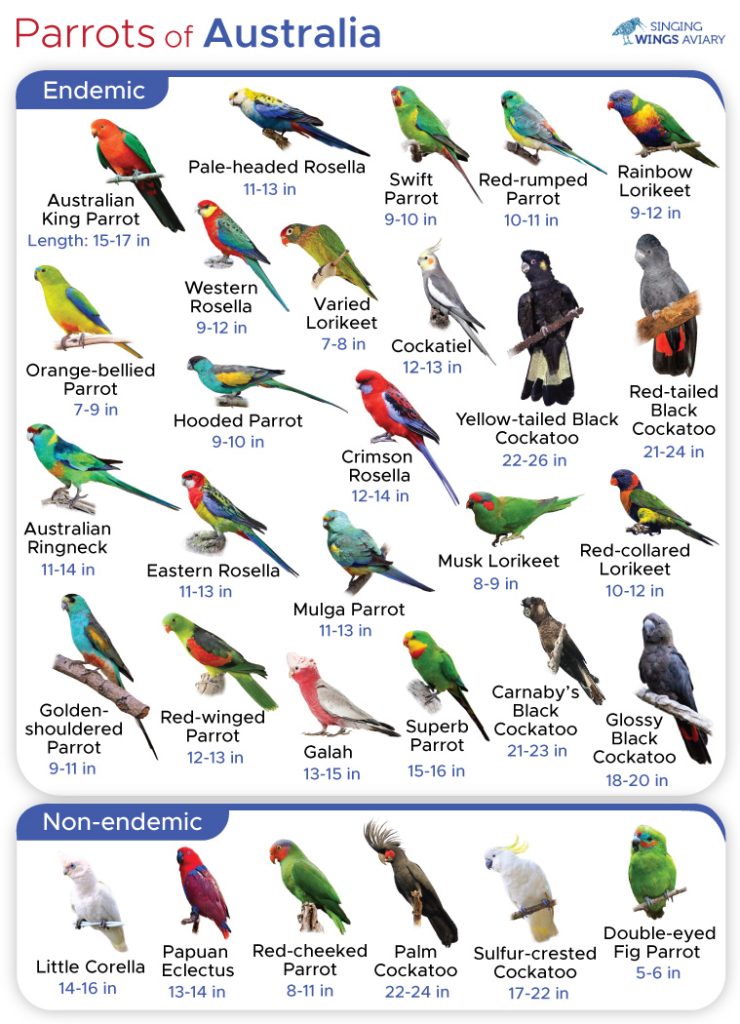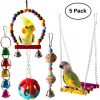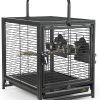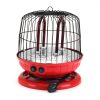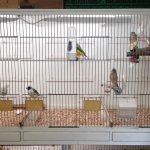Australia is home to an incredible diversity of parrots, with over 50 species native to the country, earning it the nickname “The Land of Parrots.” This remarkable variety, ranging from the giant Palm Cockatoo to the tiny Double-eyed Fig Parrot, accounts for a sixth of the over 300 parrot species found worldwide.
The unique parrot population living in Australia developed largely due to the continent’s extreme geographical isolation. Separated from the rest of the world for millions of years, Australia provided an ideal environment for these birds to thrive and evolve without external competition. Some of the most popular pet parrots today, such as the Cockatiel and the Budgerigar, originated from this isolated paradise.
List of Australian Parrots
Most of Australia’s parrots are endemic to the country. However, a few species have arrived from neighboring regions. Some of these endemic parrots are also popular pets worldwide. Even when they escape and establish feral populations elsewhere, they are still considered endemic to Australia.
| Name | Length (in) | Where They Are From | Conservation Status (IUCN) |
|---|---|---|---|
| Endemic | |||
| Australian King Parrot | 15-17 | Forests, woodlands, and urban areas in Eastern Australia | Least Concern |
| Galah | 13-15 | Woodlands, grasslands, and urban areas throughout Australia | Least Concern |
| Australian Ringneck | 11-14 | Woodlands, open forests, and scrublands across Australia | Least Concern |
| Blue-winged Parrot | 7-9 | Grasslands, heathlands, and coastal areas in southeastern Australia and Tasmania | Vulnerable (around 10,000 individuals left) |
| Bourke’s Parrot | 7-9 | Arid and semi-arid regions with open scrub and grasslands in inland Australia | Least Concern |
| Crimson Rosella | 12-14 | Forests, woodlands, and gardens in eastern and southeastern Australia | Least Concern |
| Rainbow Lorikeet | 9-12 | Rainforests, woodlands, and urban areas across eastern Australia, from northern Queensland to South Australia | Least Concern |
| Ground Parrot | 11-13 | Coastal heathlands and moorlands in southeastern Australia and Tasmania | Least Concern |
| Eastern Rosella | 11-13 | Open woodlands, farmlands, and gardens in southeastern Australia and Tasmania | Least Concern |
| Elegant Parrot | 8-9 | Dry woodlands and heathlands in southwestern Australia | Least Concern |
| Golden-shouldered Parrot | 9-11 | Savanna woodlands and open grasslands in Cape York Peninsula in Queensland | Endangered (only 300 breeding pairs left) |
| Green Rosella | 11-14 | Forests, woodlands, and gardens in Tasmania and Bass Strait islands | Least Concern |
| Hooded Parrot | 9-10 | Open woodlands and savannas in Northern Australia, especially in the Northern Territory | Least Concern |
| Little Lorikeet | 6-7 | Forests, woodlands, and urban areas in eastern Australia | Least Concern |
| Mulga Parrot | 11-13 | Arid and semi-arid scrublands and woodlands | Least Concern |
| Musk Lorikeet | 8-9 | Woodlands, forests, and gardens in southeastern Australia | Least Concern |
| Naretha Bluebonnet | 10-11 | Arid and semi-arid regions with scrublands and woodlands in southwestern Australia | – |
| Night Parrot | 9-10 | Arid regions with dense, low vegetation across inland Australia | Critically Endangered (less than 250 individuals left) |
| Northern Rosella | 11-13 | Savannas, woodlands, and forest edges across northern Australia | Least Concern |
| Orange-bellied Parrot | 7-9 | Coastal heathlands, saltmarshes, and grasslands across southeastern Australia and Tasmania | Critically Endangered (rarest parrot in Australia; only 70 individuals left) |
| Yellow-tailed Black Cockatoo | 22-26 | Forests, woodlands, and coastal areas | Least Concern |
| Pale-headed Rosella | 11-13 | Open woodlands, farmlands, and gardens in eastern Australia | Least Concern |
| Princess Parrot | 13-18 | Arid and semi-arid regions with spinifex and mulga across inland Australia | Near Threatened |
| Purple-crowned Lorikeet | 6-7 | Woodlands, forests, and coastal heathlands across southern Australia | Least Concern |
| Red-capped Parrot | 13-15 | Woodlands, forests, and farmlands across southwestern Australia | Least Concern |
| Red-collared Lorikeet | 10-12 | Woodlands, savannas, and urban areas across northern Australia | Least Concern |
| Red-rumped Parrot | 10-11 | Grasslands, woodlands, and urban areas across southeastern Australia | Least Concern |
| Red-winged Parrot | 12-13 | Woodlands, savannas, and riverine areas in northern and eastern Australia | Least Concern |
| Regent Parrot | 14-17 | Woodlands, forests, and mallee scrub across southeastern Australia | Least Concern |
| Cockatiel | 12-13 | Arid and semi-arid regions, grasslands, and open woodlands across Australia | Least Concern |
| Rock Parrot | 8-10 | Coastal heathlands, islands, and saltmarshes of southern Australia | Least Concern |
| Scarlet-chested Parrot | 7-8 | Arid and semi-arid regions with spinifex and mallee scrublands across inland Australia | Least Concern |
| Superb Parrot | 15-16 | Riverine woodlands and open forests across southeastern Australia, particularly in New South Wales | Least Concern |
| Swift Parrot | 9-10 | Migrates across the Bass Strait between the forests, woodlands, and coastal areas of Tasmania and the rest of Australia | Critically Endangered (less than 2,000 mature individuals) |
| Budgerigar | 7-8 | Grasslands, savannas, and arid regions across inland Australia | Least Concern |
| Turquoise Parrot | 8-9 | Open woodlands, forests, and grasslands across eastern Australia | Least Concern |
| Varied Lorikeet | 7-8 | Woodlands, savannas, and riverine areas across northern Australia | Least Concern |
| Western Rosella | 9-12 | Woodlands, forests, and agricultural lands across southwestern Australia | Least Concern |
| Baudin’s Black Cockatoo | 19-22 | Forests, woodlands, and agricultural lands across southwestern Australia | Critically Endangered (less than 4,000 individuals) |
| Carnaby’s Black Cockatoo | 21-23 | Woodlands, heathlands, and coastal regions across southwestern Australia | Endangered (around 34,000 individuals) |
| Long-billed Corella | 14-16 | Woodlands, grasslands, and urban areas in southeastern Australia | Least Concern |
| Gang-gang Cockatoo | 13-15 | Forests, woodlands, and mountainous regions across southeastern Australia | Vulnerable (around 25,000 individuals) |
| Glossy Black Cockatoo | 18-20 | Woodlands, forests, and coastal areas, often near drooping sheoaks, across eastern Australia | Vulnerable (less than 15,000 individuals) |
| Major Mitchell’s Cockatoo | 13-16 | Arid and semi-arid regions, woodlands, and mallee scrublands across inland Australia | Least Concern |
| Red-tailed Black Cockatoo | 21-24 | Woodlands, forests, and savannas, across northern and eastern Australia | Least Concern |
| Western Corella | 16-19 | Woodlands, grasslands, and agricultural lands across southwestern Australia | Least Concern |
| Non-endemic | |||
| Double-eyed Fig Parrot | 5-6 | Rainforests, monsoon forests, and woodlands in northeastern Australia and New Guinea | Least Concern |
| Papuan Eclectus | 13-14 | Rainforests, monsoon forests, and coastal woodlands in northern Australia, New Guinea, and surrounding islands | Least Concern |
| Red-cheeked Parrot | 8-11 | Rainforests, monsoon forests, and mangroves in northern Australia, Indonesia, and Papua New Guinea | Least Concern |
| Little Corella | 14-16 | Woodlands, grasslands, and urban areas across northern Australia and southern New Guinea | Least Concern |
| Palm Cockatoo | 22-24 | Rainforests, monsoon forests, and woodlands in Cape York Peninsula in Queensland, New Guinea, and the Aru Islands | Near Threatened |
| Sulfur-crested Cockatoo | 17-22 | Woodlands, forests, and urban areas across northern and eastern Australia, Indonesia, and New Guinea | Least Concern |
The Paradise Parrot, once native to Australia, was last seen in 1927 and is now presumed extinct. Similarly, the Night Parrot was also believed to be extinct after its last sighting in 1912, but it was later confirmed to be alive after being rediscovered in 1979.


